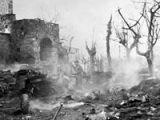What happened that day?
See historic events for any day of the year by entering the date below. Why not try your birthday?
Kiwi of the Week
Today in History

1944 NZ forces capture Castle Hill at Cassino
On 15 March 1944 the 6th New Zealand Brigade attacked the Italian town of Cassino as part of the Allies’ advance on Rome. This was one of four Allied assaults on the German defences at Cassino between January and May 1944. The New Zealand Division played a significant part in this campaign and by the time it was withdrawn in early April, 343 New Zealanders had lost their lives.
The success of the 15 March attack on the tactically important Castle Hill depended on the effectiveness of a planned bombing campaign. Troops had been waiting three weeks in freezing rain for suitable weather for an aerial assault. Bombarded from the air and land, Cassino was reduced to a pile of rubble. But the German defenders rallied quickly and put up staunch resistance. In conditions reminiscent of the First World War, Allied armour and infantry were held up by bomb craters that flooded as heavy rain set in, turning the rubble into a morass. Communications were difficult and progress was slower than expected. One New Zealand battalion did manage to seize Castle Hill, but by dusk the attack had lost its impetus.
Over the next eight days more New Zealand troops entered Cassino, but they were unable to make any headway. On 23 March all attacks were called to a halt and the New Zealanders went on the defensive. Cassino did not fall until 18 May 1944, when it was occupied by Polish troops with the assistance of New Zealand artillery.
Image: a shell blast near Cassino, 1944
Internal links

1844 New Zealand Company ends colonising efforts
Having struggled financially for some years, the Company was in great difficult by early 1844 in the wake of the Wairau Affair of June 1843.














